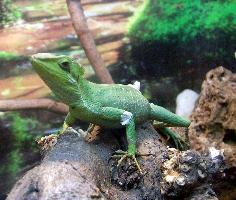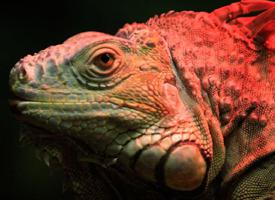
Weights and measures
| Length | from 51 to 76 cm |
|---|---|
| Weight | 14 kg |
State of endangerment
| Endangered |
Animal description
The Blue Iguana, scientifically known as Cyclura lewisi, is a striking and rare species of lizard endemic to the island of Grand Cayman in the Caribbean. This large, herbivorous reptile is most notable for its vibrant blue coloration, which can range from a subtle blue-grey to a bright azure, intensifying in males during the breeding season or when displaying aggression. The blue hue is not just a matter of beauty but also serves as a means of communication among individuals.Adult Blue Iguanas can reach impressive lengths of up to 5 feet (1.5 meters) from head to tail, making them one of the largest species of iguana in the Americas. Their bodies are robust and muscular, adapted for a life of foraging on the ground. They possess strong limbs ending in sharp claws, which are adept for digging burrows for nesting or escaping the midday heat. Their skin is thick and leathery, with a dorsal crest of spiny scales running along the back, which becomes more pronounced in males.
The diet of the Blue Iguana primarily consists of a wide variety of plant material, including fruits, flowers, and leaves, which they forage during the cooler parts of the day. They have also been known to occasionally consume insects and other small invertebrates. This herbivorous diet plays a crucial role in their ecosystem, as they are important seed dispersers for many native plants.
Historically, the Blue Iguana faced a critical threat of extinction due to habitat destruction, predation by invasive species, and over-collection for the pet trade. By the early 2000s, their numbers in the wild had dwindled to a critical low, with fewer than 15 individuals estimated to be living in their natural habitat. However, through rigorous conservation efforts, including captive breeding and release programs, habitat restoration, and public education, the population of Blue Iguanas has begun to recover. These efforts have highlighted the importance of conservation and the impact of human intervention in preserving endangered species.
The Blue Iguana has a distinct social structure and behavior. They are generally solitary creatures, with males being particularly territorial, especially during the mating season. They use visual displays, body postures, and their vibrant coloration to communicate with each other, whether to establish dominance, attract mates, or ward off potential threats. Despite their fierce appearance, they are known to exhibit a range of personalities, with some individuals becoming quite tame and approachable in captivity.
Reproduction in Blue Iguanas involves elaborate courtship rituals, with males displaying their most vibrant colors and engaging in head-bobbing to attract females. After mating, females lay clutches of eggs in burrows, which they meticulously excavate in sandy or soft soil. The eggs incubate for several months before hatching, with the young iguanas emerging fully independent, ready to fend for themselves.
In summary, the Blue Iguana (Cyclura lewisi) is a fascinating and beautiful species with a remarkable story of conservation. Through dedicated efforts, this symbol of resilience and natural beauty continues to recover from the brink of extinction, serving as a beacon of hope for the preservation of endangered species worldwide. Their existence underscores the delicate balance of ecosystems and the critical role that each species plays within it.
Similar Animals
New photos of animals
Top 10 animals
- Dolphin gull (Leucophaeus scoresbii)
- Diana monkey (Cercopithecus diana)
- Moustached guenon (Cercopithecus cephus)
- Galápagos tortoise (Geochelone nigra complex)
- Stone loach (Barbatula barbatula)
- Japanese macaque (Macaca fuscata)
- Greek tortoise (Testudo graeca)
- Russian tortoise (Testudo horsfieldii)
- Common flying dragon (Draco volans)
- Galápagos penguin (Spheniscus mendiculus)


